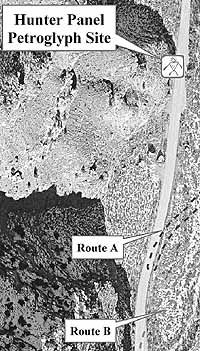| A map depicts where the advisory committee members and Bill Barrett Corporation propose to reroute the road in Cottonwood Canyon around Nine Mile’s popular Hunter rock art panel. |
For years, competing interests in Nine Mile have argued about the direction to take in the canyon, but the groups have accomplished little in resolving the problems.
But in the last few months the Nine Mile Canyon Advisory Board has started to change the direction of the various parties and finally it seems the vessel is beginning to sail in a unified direction.
Many members of the group, some veterans of various conflicts that have erupted about the canyon, are apparently beginning to see light at the end of the tunnel.
Recently, the advisory committee came to a consensus on rerouting the road in Cottonwood Canyon so it will run around the Hunter rock panel, protecting the site from the dust created by motor vehicles.
That was the first step in a long process of finding ways for all the groups to work together to utilize the canyon to it’s fullest, without destroying it’s uniqueness.
At the meeting on March 4 the group also discussed what could be done with the Rassmussen Cave area as well.
The property where the cave is located is presently owned by the Bill Barrett Corporation, a deep well coalbed methane gas development company based in Colorado.
“It’s a subject I wanted to throw out and have everyone comment on about what we can and can’t do in the area,” explained Bill Griffith of BBC to the group. “I would like to have the experts in our group evaluate that site to see what could be done to improve it.”
There are many concerns regarding the particular area.
Some people have been concerned about the nearby compressor stations making too much noise, while others have been concerned that too much development around the cave, so the public can view the site, might actually cause problems with remains from civilizations long past.
Archaeologists in the group discussed the fact that many of the remains in the area are hundreds of years old and even excavation for improved pathways to the cave could disturb important buried remnants of ancient societies.
As with all types of groups that want to take action, money to finance activities is an important factor.
The groups discussed grants and funding, particularly applying to the Carbon County Restaurant Tax Committee for funding to complete several projects in the Nine Mile Canyon area.
“The problem is that, the way this group is set up, we cannot legally apply for funds from that committee,” said Pam Miller, College of Eastern Utah archaeologist. “However, the Nine Mile Coalition could apply for funds to do some of the things the advisory board wants to do.”
Following Miller’s comments, a discussion ensued about possible projects and where the group wants to head in connection with the Nine Mile area.
“I guess the most important point about getting money from the RTC is that we need to pinpoint what we want to work on and then ask for what we need,” indicated Carbon County Commissioner Steve Burge, who is a member of the advisory committee. “Then once we have accomplished those things, we can go back and ask for more.”
Important shareholders in Nine Mile Canyon who have been missing from the advisory group are private landowners.
The committee discussed how private property owners could be brought into the fold so they can have input into what is going on in the canyon.
It was suggested that the minutes of the meetings be sent to all landowners in the canyon to not only inform, but to prompt the shareholders to become interested in what the advisory board is doing.
Finally, the group discussed what the mission of the advisory board should be.
Since the panel was only formed several months ago, general ideas of what the board should be doing are available.
But as of yet, there is no specific direction established for the members to follow, primarily because the committee does not have a mission statement.
Advisory panel chairman Cliff Coppersmith suggested that any mission statement developed for the committee should be basic and help members in the group to “work through problems and find common ground.”

